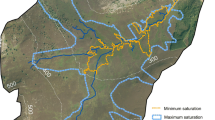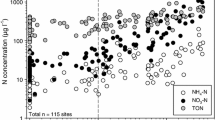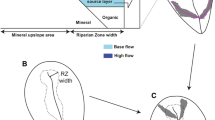Abstract
We bring together three decades of research from a boreal catchment to facilitate an improved mechanistic understanding of surface water dissolved organic carbon (DOC) regulation across multiple scales. The Krycklan Catchment Study encompasses 15 monitored nested research catchments, ranging from 3 to 6900 ha in size, as well as a set of monitored transects of forested and wetland soils. We show that in small homogenous catchments, hydrological functioning provides a first order control on the temporal variability of stream water DOC. In larger, more heterogeneous catchments, stream water DOC dynamics are regulated by the combined effect of hydrological mechanisms and the proportion of major landscape elements, such as wetland and forested areas. As a consequence, streams with heterogeneous catchments undergo a temporal switch in the DOC source. In a typical boreal catchment covered by 10-20% wetlands, DOC originates predominantly from wetland sources during low flow conditions. During high flow, the major source of DOC is from forested areas of the catchment. We demonstrate that by connecting knowledge about DOC sources in the landscape with detailed hydrological process understanding, an improved representation of stream water DOC regulation can be provided. The purpose of this study is to serve as a framework for appreciating the role of regulating mechanisms, connectivity and scaling for understanding the pattern and dynamics of surface water DOC across complex landscapes. The results from this study suggest that the sensitivity of stream water DOC in the boreal landscape ultimately depends on changes within individual landscape elements, the proportion and connectivity of these affected landscape elements, and how these changes are propagated downstream.





Similar content being viewed by others
References
Ågren A, Buffam I, Jansson M, Laudon H. 2007a. Importance of seasonality and small streams for the landscape regulation of dissolved organic carbon export. J Geophys Res 112: doi: 03010.01029/02006JG000381.
Ågren A, Jansson M, Ivarsson H, Bishop K, Seibert J. 2007b. Seasonal and runoff-related changes in allochtonous organic carbon concentrations in the River Öre, Northern Sweden. Aquat Sci 70:21–9.
Ågren A, Berggren M, Laudon H, Jansson M. 2008. Terrestrial export of highly bioavailable carbon from small boreal catchments in spring floods. Freshw Biol 53:964–72.
Ågren A, Buffam I, Bishop K, Laudon H. 2010. Modeling stream dissolved organic carbon concentrations during spring flood in the boreal forest: a simple empirical approach for regional predictions. J Geophys Res Biogeosci. doi:10.1029/2009JG001013.
Baker M, Weller D, Jordan T. 2006. Improved methods for quantifying potential nutrient interception by riparian buffers. Landscape Ecol 21:1327–45.
Berggren M, Laudon H, Jansson M. 2007. Landscape regulation of bacterial growth efficiency in boreal freshwaters. Glob Biogeochem Cycle 21. doi:4010.1029/2006GB002844.
Berggren M, Laudon H, Jansson M. 2009. Hydrological control of organic carbon support for bacterial growth in boreal headwater streams. Microb Ecol 57:170–8.
Berggren M, Laudon H, Haei M, Strom L, Jansson M. 2010. Efficient aquatic bacterial metabolism of dissolved low-molecular-weight compounds from terrestrial sources. ISME J 4:408–16.
Bergknut M, Meijer S, Halsall C, Ågren A, Laudon H, Köhler S, Jones KC, Tysklind M, Wiberg K. 2010a. Modelling the fate of hydrophobic organic contaminants in a boreal forest catchment: a cross disciplinary approach to assessing diffuse pollution to surface waters. Environ Pollut 158:2964–9.
Bergknut M, Laudon H, Wiberg K. 2010b. Dioxins, PCBs, and HCB in soil and peat profiles from a pristine boreal catchment. Environ Pollut 158:2518–25.
Billett MF, Deacon CM, Palmer SM, Dawson JJC, Hope D. 2006. Connecting organic carbon in stream water and soils in a peatland catchment. J Geophys Res Biogeosci 111: doi:10.1029/2005JG000065.
Bishop KH. 1991. Episodic increases in stream acidity, catchment flow pathways and hydrograph separation. University of Cambridge. 246 pp.
Bishop K, Pettersson C. 1996. Organic carbon in the boreal spring flood from adjacent subcatchments. Environ Int 22:535–40.
Bishop K, Lee YH, Pettersson C, Allard B. 1995. Terrestrial sources of methylmercury in surface waters—the importance of the riparian zone on the Svartberget catchment. Water Air Soil Pollut 80:435–44.
Bishop K, Seibert J, Köhler S, Laudon H. 2004. Resolving the Double Paradox of rapidly mobilized old water with highly variable responses in runoff chemistry. Hydrol Process 18:185–9.
Björkvald L, Buffam I, Laudon H, Mörth CM. 2008. Hydrogeochemistry of Fe and Mn in small boreal streams: the role of seasonality, landscape type and scale. Geochim Cosmochim Acta 72:2789–804.
Björkvald L, Giesler R, Laudon H, Humborg C, Mörth CM. 2009. Landscape variations in stream water SO4 2− and delta S-34(SO4) in a boreal stream network. Geochim Cosmochim Acta 73:4648–60.
Böhner J, Blaschke T, Montanarella L, Eds. 2008. SAGA: system for an automated geographical analysis. Hamburg: Institute of Geography, University of Hamburg.
Buffam I, Laudon H, Temnerud J, Mörth C-M, Bishop K. 2007. Landscape-scale variability of acidity and dissolved organic carbon during spring flood in a boreal stream network. J Geophys Res 112. doi:10.1029/2006JG000218.
Buffam I, Laudon H, Seibert J, Morth CM, Bishop K. 2008. Spatial heterogeneity of the spring flood acid pulse in a boreal stream network. Sci Total Environ 407:708–22.
Canham CD, Pace ML, Papaik MJ, Primack AGB, Roy KM, Maranger RJ, Curran RP, Spada DM. 2004. A spatially explicit watershed-scale analysis of dissolved organic carbon in Adriondack lakes. Ecol Appl 14:839–54.
Clair TA, Dennis IF, Vet R, Laudon H. 2008. Long-term trends in catchment organic carbon and nitrogen exports from three acidified catchments in Nova Scotia, Canada. Biogeochemistry 87:83–97.
Clark JM, Bottrell SH, Evans CD, Monteith DT, Bartlett R, Rose R, Newton RJ, Chapman PJ. 2010. The importance of the relationship between scale and process in understanding long-term DOC dynamics. Sci Total Environ 408:2768–75.
Cole JJ, Prairie YT, Caraco NF, McDowell WH, Tranvik LJ, Striegl RG, Duarte CM, Kortelainen P, Downing JA, Middelburg JJ, Melack J. 2007. Plumbing the global carbon cycle: integrating inland waters into the terrestrial carbon budget. Ecosystems 10:171–84.
Conrad O. 2007. SAGA—Entwurf, Funktionsumfang und Anwendung eines Systems für Automatisierte Geowissenschaftliche Analysen. Göttingen: Physical Geography, University of Göttingen. p 221.
Cory N, Buffam I, Laudon H, Köhler S, Bishop K. 2006. Landscape control of stream water aluminum in a boreal catchment during spring flood. Environ Sci Technol 40:3494–500.
Cory N, Laudon H, Köhler S, Seibert J, Bishop K. 2007. Evolution of soil solution aluminum during transport along a forested boreal hillslope. J Geophys Res Biogeosci 112. doi:10.1029/2006JG000387.
Cory N, Buffam I, Laudon H, Björkvald L, Mörth CM, Köhler S, Bishop K. 2009. Particulate aluminium in boreal streams: towards a better understanding of its sources and influence on dissolved aluminium speciation. Appl Geochem 24:1677–85.
Creed IF, Sanford SE, Beall FD, Molot LA, Dillon PJ. 2003. Cryptic wetlands: integrating hidden wetlands in regression models of the export of dissolved organic carbon from forested landscapes. Hydrol Process 17:3629–48.
Creed IF, Beall FD, Clair TA, Dillon PJ, Hesslein RH. 2008. Predicting export of dissolved organic carbon from forested catchments in glaciated landscapes with shallow soils. Glob Biogeochem Cycles 22. doi:10.1029/2008GB003294.
De Wit HA, Mulder J, Hindar A, Hole L. 2007. Long term increase in dissolved organic carbon in stream waters in Norway is response to reduced acid deposition. Environ Sci Technol 41:7706–13.
Dillon PJ, Molot LA. 1997. Effect of landscape form on export of dissolved organic carbon, iron, and phosphorus from forested stream catchments. Water Resour Res 33:2591–600.
Eimers MC, Watmough SA, Buttle JM, Dillon PJ. 2008a. Examination of the potential relationship between droughts, sulphate and dissolved organic carbon at a wetland-draining stream. Glob Change Biol 14:938–48.
Eimers MC, Buttle J, Watmough SA. 2008b. Influence of seasonal changes in runoff and extreme events on dissolved organic carbon trends in wetland- and upland-draining streams. Can J Fish Aquat Sci 65:796–808.
Erlandsson M, Buffam I, Fölster J, Laudon H, Temnerud J, Weyhenmeyer GA, Bishop K. 2008. Thirty-five years of synchrony in the organic matter concentrations of Swedish rivers explained by variation in flow and sulphate. Glob Change Biol 14:1191–8.
Findlay S, Quinn JM, Hickey CW, Burrell G, Downes M. 2001. Effects of land use and riparian flowpath on delivery of dissolved organic carbon to streams. Limnol Oceanogr 46:345–55.
Frost PC, Larson JH, Johnston CA, Young KC, Maurice PA, Lamberti GA, Bridgham SD. 2006. Landscape predictors of stream dissolved organic matter concentrations and physiochemistry in a Lake Superior river watershed. Aquat Sci 68:40–51.
Gergel SE, Turner MG, Kratz TK. 1999. Dissolved organic carbon as an indicator of the scale of watershed influence on lakes and rivers. Ecol Appl 9:1377–90.
Giesler R, Björkvald L, Laudon H, Mörth CM. 2009. Spatial and seasonal variations in stream water delta S-34-dissolved organic matter in Northern Sweden. Environ Sci Technol 43:447–52.
Gorham E, Underwood JK, Janssens JA, Freedman B, Maass W, Waller DH, Ogden JG. 1998. The chemistry of streams in southwestern and central Nova Scotia, with particular reference to catchment vegetation and the influence of dissolved organic carbon primarily from wetlands. Wetlands 18:115–32.
Grabs T. 2010. Water quality modeling based on landscape analysis: importance of riparian hydrology. Ph.D. thesis, Department of Physical Geography and Quaternary Geology No 24, Stockholm University, Sweden.
Haaland S, Hongve D, Laudon H, Riise G, Vogt RD. 2010. Quantifying the drivers of the increasing colored organic matter in boreal surface waters. Environ Sci Technol 44:2975–80.
Hinton MJ, Schiff SL, English MC. 1997. The significance of storms for the concentration and export of dissolved organic carbon from two Precambrian Shield catchments. Biogeochemistry 36:67–88.
Hinton MJ, Schiff SL, English MC. 1998. Sources and flowpaths of dissolved organic carbon during storms in two forested watersheds of the Precambrian Shield. Biogeochemistry 41:175–97.
Hornberger GM, Bencala KE, McKnight DM. 1994. Hydrological controls on dissolved organic-carbon during snowmelt in the Snake River near Montezuma, Colorado. Biogeochemistry 25:147–65.
Hruska J, Köhler S, Laudon H, Bishop K. 2003. Is a universal model of organic acidity possible: comparison of the acid/base properties of dissolved organic carbon in the boreal and temperate zones. Environ Sci Technol 37:1726–30.
IPCC. 2007. Climate Change 2007: The physical science basis. Contribution of working group I to the fourth assessment report of the Intergovernmental Panel on Climate Change. 996 pp.
Jansson M, Persson L, De Roos AM, Jones R, Tranvik LJ. 2007. Terrestrial carbon and intraspecific size-variation shape lake ecosystems. Trends Ecol Evol 22:316–22.
Klaminder J, Grip H, Mörth CM, Laudon H. 2011. Carbon mineralization and pyrite oxidation in groundwater: importance for silicate weathering in boreal forest soils and stream base-flow chemistry. Appl Geochem 26:319–25.
Köhler SJ, Buffam I, Laudon H, Bishop KH. 2008. Climate’s control of intra-annual and interannual variability of total organic carbon concentration and flux in two contrasting boreal landscape elements. J Geophys Res Biogeosci 113. doi:10.1029/2007JG000629.
Köhler SJ, Buffam I, Seibert J, Bishop KH, Laudon H. 2009. Dynamics of stream water TOC concentrations in a boreal headwater catchment: controlling factors and implications for climate scenarios. J Hydrol 373:44–56.
Laudon H, Buffam I. 2008. Impact of changing DOC concentrations on the potential distribution of acid sensitive biota in a boreal stream network. Hydrol Earth Syst Sci 12:425–35.
Laudon H, Köhler S, Buffam I. 2004a. Seasonal TOC export from seven boreal catchments in northern Sweden. Aquat Sci 66:223–30.
Laudon H, Seibert J, Köhler S, Bishop K. 2004b. Hydrological flow paths during snowmelt: congruence between hydrometric measurements and oxygen 18 in meltwater, soil water, and runoff. Water Resources Research 40. doi:03110.10292003WR10002455.
Laudon H, Sjöblom V, Buffam I, Seibert J, Mörth M. 2007. The role of catchment scale and landscape characteristics for runoff generation of boreal streams. J Hydrol 344:198–209.
Laudon H, Hedtjärn J, Schelker J, Bishop K, Sörensen R, Ågren A. 2009. Response of dissolved organic carbon following forest harvesting in a boreal forest. Ambio 38:381–6.
Lidman F, Björkvald L, Mörth C-M, Laudon H. 2011. Selenium dynamics in boreal streams: the role of wetlands and changing groundwater tables. Environ Sci Technol 45:2677–83.
Likens GE, Buso DC. 2006. Variation in streamwater chemistry throughout the Hubbard Brook Valley. Biogeochemistry 78:1–30.
Lundin L. 1982. Soil moisture and ground water in till soil and the significance of soil type for runoff. UNGI Report No. 56. Uppsala University, Uppsala. 216 pp.
Lyon SW, Laudon H, Seibert J, Mörth CM, Tetzlaff D, Bishop K. 2010. Controls on snowmelt water mean transit times in northern boreal catchments. Hydrol Process 24:1672–84.
Lyon SW, Grabs T, Laudon H, Bishop KH, Seibert J. 2011. Variability of groundwater levels and total organic carbon (TOC) in the riparian zone of a boreal catchment. J Geophys Res Biogeosci. doi:10.1029/2010JG001452.
McGlynn BL, McDonnell JJ. 2003. Role of discrete landscape units in controlling catchment dissolved organic carbon dynamics. Water Resources Res 39. doi:10.1029/2002WR001525.
Monteith DT, Stoddard JL, Evans CD, de Wit HA, Forsius M, Hogasen T, Wilander A, Skjelkvale BL, Jeffries DS, Vuorenmaa J, Keller B, Kopacek J, Vesely J. 2007. Dissolved organic carbon trends resulting from changes in atmospheric deposition chemistry. Nature 450:U537–9.
Mulholland PJ. 2003. Large-scale patterns in dissolved organic carbon concentration, flux, and sources. In: Findlay S, Sinsabaugh R, Eds. Aquatic ecosystems: interactivity of dissolved organic matter. Amsterdam: Elsevier. p 139–59.
Nilsson M, Mikkela C, Sundh I, Granberg G, Svensson BH, Ranneby B. 2001. Methane emission from Swedish mires: national and regional budgets and dependence on mire vegetation. J Geophys Res Atmos 106:20847–60.
Nilsson M, Sagerfors J, Buffam I, Laudon H, Eriksson T, Grelle A, Klemedtsson L, Weslien P, Linderoth A. 2008. Complete carbon budgets for two years of a boreal oligotrophic minerogenic mire. Glob Change Biol 14:1–16.
Petrone KC, Jones JB, Hinzman LD, Boone, RD. 2006. Seasonal export of carbon, nitrogen, and major solutes from Alaskan catchments with discontinuous permafrost. J Geophys Res Biogeosc 111. doi:10.1029/2005JG000055.
Petrone K, Buffam I, Laudon H. 2007. Hydrologic and biotic control of nitrogen export during snowmelt: a combined conservative and reactive tracer approach. Water Resources Res 43. doi:10.1029/2006WR005286.
Pregitzer KS, Euskirchen ES. 2004. Carbon cycling and storage in world forests: biome patterns related to forest age. Glob Change Biol 10:2052–77.
Rodhe A. 1987. The origin of streamwater traced by Oxygen-18. Uppsala University, Uppsala. 260 pp.
Rodhe A. 1989. On the generation of stream runoff in till soils. Nordic Hydrol 20:1–8.
Sarkkola S, Koivusalo H, Lauren A, Kortelainen P, Mattsson T, Palviainen M, Piirainen S, Starr M, Finer L. 2009. Trends in hydrometeorological conditions and stream water organic carbon in boreal forested catchments. Sci Total Environ 408:92–101.
Schiff S, Aravena R, Mewhinney E, Elgood R, Warner B, Dillon P, Trumbore S. 1998. Precambrian shield wetlands: hydrologic control of the sources and export of dissolved organic matter. Clim Change 40:167–88.
Seibert J, McGlynn BL. 2007. A new triangular multiple flow direction algorithm for computing upslope areas from gridded digital elevation models. Water Resources Res 43. doi:10.1029/2006WR005128.
Seibert J, Bishop K, Rodhe A, McDonnell JJ. 2003. Groundwater dynamics along a hillslope: a test of the steady state hypothesis. Water Resources Res 39. doi:10.1029/2002WR001404.
Seibert J, Grabs T, Kohler S, Laudon H, Winterdahl M, Bishop K. 2009. Linking soil- and stream-water chemistry based on a Riparian Flow-Concentration Integration Model. Hydrol Earth Syst Sci 13:2287–97.
Shafer MM, Overdier JT, Hurley JP, Armstrong D, Webb D. 1997. The influence of dissolved organic carbon, suspended particulates, and hydrology on the concentration, partitioning and variability of trace metals in two contrasting Wisconsin watersheds (USA). Chem Geol 136:71–97.
Sirin A, Bishop K, Köher S. 1998. Resolving flow pathways and geochemistry in a headwater forested wetland with multiple traces. HeadWater ‘98 Conference. IAHS Publ., Merano, Italy. pp 337–42.
Temnerud J, Fölster J, Buffam I, Laudon H, Erlandsson M, Bishop K. 2010. Can the distribution of headwater stream chemistry be predicted from downstream observations? Hydrol Process 24:2269–76.
Wallin M, Buffam I, Öquist M, Laudon H, Bishop K. 2010. Temporal and spatial variability of dissolved inorganic carbon in a boreal stream network—concentrations and downstream fluxes. J Geophys Res 115. doi:10.1029/2009JG001100.
Wilson HF, Xenopoulos MA. 2008. Ecosystem and seasonal control of stream dissolved organic carbon along a gradient of land use. Ecosystems 11:555–68.
Yurova A, Sirin A, Buffam I, Bishop K, Laudon H. 2008. Modeling the dissolved organic carbon output from a boreal mire using the convection-dispersion equation: importance of representing sorption. Water Resources Res 44. doi:10.1029/2007wr006523.
Acknowledgments
The financial support for this study has over the years been provided by Swedish Science Foundation, Formas, ForWater, Swedish EPA, SKB, SLU and Future Forest. Numerous people have been involved in the sampling and lab work of which we especially thank Elof Manfredsson, Hans-Göran Nilsson and Peder Blomkvist. We also thank three anonymous reviewers for their suggested improvements of the text.
Author information
Authors and Affiliations
Corresponding author
Additional information
Author Contributions
H.L wrote the manuscript with active contributions from all co-authors. Data from this study has been collected over close to 30 years and would not have been possible without the important work by K.B., S.K., I.B., M.B., and H.L. The conceptual and more mechanistic modeling approach has been developed by H.L. together with all co-authors.
Rights and permissions
About this article
Cite this article
Laudon, H., Berggren, M., Ågren, A. et al. Patterns and Dynamics of Dissolved Organic Carbon (DOC) in Boreal Streams: The Role of Processes, Connectivity, and Scaling. Ecosystems 14, 880–893 (2011). https://doi.org/10.1007/s10021-011-9452-8
Received:
Accepted:
Published:
Issue Date:
DOI: https://doi.org/10.1007/s10021-011-9452-8




